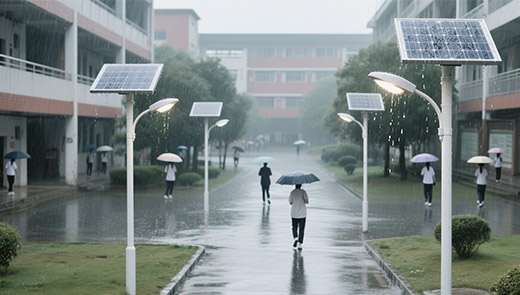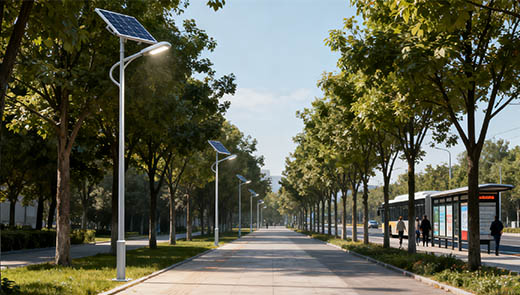What Is the IP Rating Standard for Solar Street Lights?
As a common outdoor lighting equipment, solar street lights need to face dust, rain and other complex environments, and the IP protection rating is the core standard to measure their ability to resist these intrusions. Understanding the meaning of IP ratings, the protection performance of different ratings, and how to choose the appropriate rating with regard to climate, installation location, and so on, is crucial to ensuring the durability, stability, and safety of street lights. This article will focus on these points.
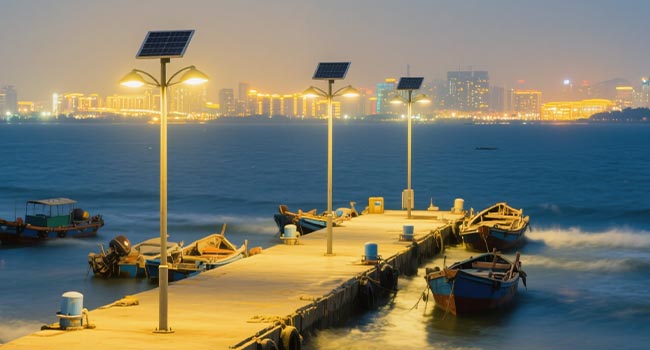
What Is IP Rating?
IP stands for Ingress Protection, meaning ingress protection, which is mainly used to measure the ability of outdoor lamps to resist moisture, dust and other objects, generally speaking, the higher the value, the stronger the protection ability. IP rating consists of two numbers, the first one represents the protection against solid objects (dust, dirt, etc.). (The first number represents the level of protection against solid objects (dust, dirt, etc.) and the second number corresponds to the level of protection against moisture (water). When purchasing an outdoor luminaire, one basic criterion is to choose a product with an IP rating of IP45 and above, as this is the basic requirement to cope with the complexity of the outdoor environment.
IP Rating: What Does The First Digit Mean?
The first digit is for solid particles such as dust, dirt, etc. These particles, if they come into contact with an electrical conductor, are likely to cause damage that will affect the normal operation of the luminaire, so its protection is critical. The value of this digit ranges from 0 to 6, with different values corresponding to different levels of protection, as follows:
|
First Digit |
Protection Level Description |
|
0 |
No protection; does not prevent the entry of solid objects |
|
1–5 |
Increasing protection; blocks solid objects of various sizes |
|
6 |
Complete protection; effectively prevents entry of all solid objects |
IP Rating: What Does the Second Digit Mean?
The second digit is for moisture, and is used to ensure that the equipment inside the luminaire stays dry when exposed to different forms of moisture such as water droplets, sprays and immersion. For outdoor luminaires, not only do they have to be able to withstand rain and storms, but they also have to cope with the moisture generated during cleaning. This number takes values between 0-9, with different values corresponding to differences in protection as follows:
|
Second Digit |
Protection Level Description |
|
0 |
No protection; cannot resist moisture |
|
1–8 |
Increasing protection; resists various levels of moisture such as dripping, spraying, etc. |
|
9 |
Full protection; withstands high-temperature spray, jet cleaning, and steam cleaning |
IP Ratings for Solar Street Lights
IP65
IP65 provides protection against dust, which means that dust cannot get inside the street light and affect the components. It is also resistant to low-pressure water jets in any direction and can cope with daily rain splashes. This rating is suitable for areas with mild climates, where the weather is relatively stable and precipitation and dust are low.
IP66
IP66 is also fully dustproof, keeping out dust. It is also resistant to high-pressure water jets, and will work even when subjected to heavy rainfall. This class is suitable for areas with heavy rainfall or high humidity, and can meet the protection needs of such environments.
IP67
IP67 is not only completely dust-proof, preventing damage to internal components from dust, but can also be immersed in water up to 1 meter deep for 30 minutes without being affected. It is therefore recommended for use in areas prone to flooding or extreme weather conditions, and is able to maintain its normal condition in harsher water environments.
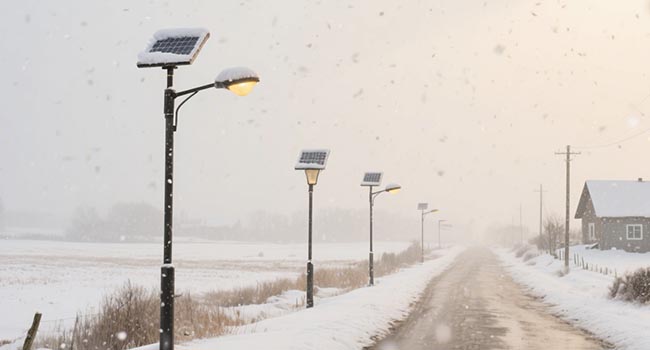
Importance of Protection Levels for Solar Street Lights
Durability
High IP rating can build a strong “protection wall” for the core components such as LEDs, solar panels, batteries, etc. inside the solar street light, effectively blocking the intrusion of water and dust. The high IP rating builds a strong “wall of protection” for the LEDs, solar panels, batteries and other core components inside the solar street light, effectively blocking water and dust intrusion. In the outdoor environment, dust is pervasive, and its long-term accumulation may cover the surface of electronic components, affecting heat dissipation and even leading to poor contact between components. Once rain, dew and other moisture penetrate the device, it is easy to cause corrosion and short-circuit problems.
With a high IP rating, these components are protected from such damage, which significantly extends the service life of the street lights. This not only reduces the need for frequent maintenance due to component damage, such as replacing damaged LEDs and cleaning dust buildup on the solar panels, but also reduces the frequency of replacing the entire street light, which significantly reduces labor and material costs from a long-term perspective.
Performance
The performance of a solar street light depends largely on the proper functioning of the components, and the protection level has a direct impact on this. Solar panel is a key component to absorb solar energy and convert it into electricity, if the protection level is insufficient, dust will gradually accumulate on its surface, like a layer of “veil” to the solar panel, greatly reducing its absorption efficiency of sunlight, which in turn affects the effect of photoelectricity conversion, resulting in a reduction in the power stored in the street lamps, and may appear lighting time shortened, insufficient brightness and other problems.
At the same time, the street lamp internal electrical components are extremely sensitive to moisture, moisture into the circuit may lead to a short circuit, which may cause the street lamp brightness is unstable, light and dark, or make the street lamp stop working completely. Appropriate protection level can avoid these problems from the source, ensure that the solar panel always maintains high conversion efficiency, and the electrical components can also operate stably, so that the street light continues to maintain the best lighting performance in long-term use.
Safety
Safety is an important factor that cannot be ignored in the use of solar street lights, and the protection level plays a key role in it. When the electrical components are eroded by water or dust, their insulation performance will be greatly reduced, which is like laying a “time bomb” for safety. In humid environments, contact between energized parts and water may lead to leakage of electricity, and if pedestrians or maintenance personnel inadvertently come into contact with them, they are very likely to cause electrocution accidents. In addition, excessive dust buildup can cause components to overheat, which under certain conditions can even lead to fires, especially in areas with a high concentration of flammable materials.
A high level of protection provides reliable protection for electrical components, effectively insulating them from water and dust and maintaining their insulation and heat dissipation, thus reducing the probability of electrocution, fire and other safety hazards. This is especially important in crowded streets, parks, schools and other public areas, which can provide strong protection for the public's safe travel and activities.
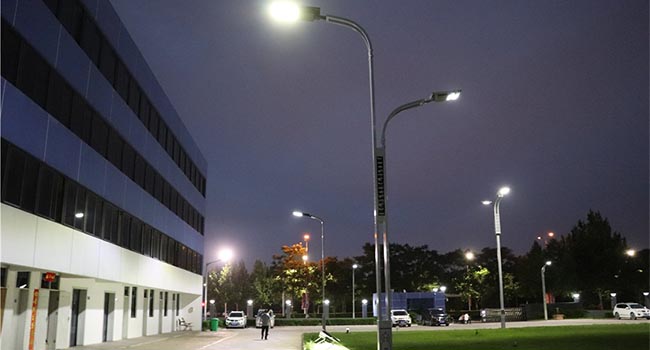
Considerations When Choosing a Solar Street Light Based on Protection Level
Climate
Climatic conditions vary significantly from region to region, which directly determines the level of protection required for solar street lights. In areas with high rainfall and snowfall, such as the rainy season in the south and some snowy northern areas, the street light will be in a humid environment for a long time, the rain may hit the street light with a large impact, and the melting of the snow will also produce a lot of water, which is why it is necessary to choose a solar street light with a high protection level of IP67 and above, in order to resist the continuous and strong water intrusion.
In dusty areas, such as those near construction sites, mining areas or the edge of deserts, the high concentration of dust in the air tends to adhere to the surface of the street light and try to penetrate into the interior, so a high IP rating can effectively block the entry of dust and avoid damage to the internal components.
On the other hand, in dry climates with low rainfall and low airborne dust content, such as some mild plains, where the street lights face less threat from water and dust, an IP65 rating is usually sufficient to ensure proper protection without over-performance and waste of cost.
Location
The environmental characteristics of the installation location is a factor that must be considered when choosing the protection level of solar street lights. Seaside is a special installation scenario, the seaside air contains a lot of salt, these salts with the formation of sea breeze brine spray is very corrosive, not only will erode the street light shell, but also may penetrate through the gaps into the internal, on the metal parts and electronic components caused by serious corrosion.
Therefore, installed in the seaside solar street lights, in addition to the need for high IP rating to block moisture and dust, but also must choose to use corrosion-resistant materials made of products, such as corrosion-resistant aluminum alloy shell or stainless steel, the internal components of anti-corrosion treatment, etc., so as to be able to ensure that the street lights have a longer service life in the high IP rating and corrosion-resistant materials under the double protection. In addition, like some areas close to fountains and pools, the street light may often be affected by water mist, and also need to choose a higher level of protection to cope with this special water vapor environment.
Application
Different application scenarios have different protection requirements for solar street lights. On the one hand, the industrial production process may generate a lot of dust and pollutants, which are more hazardous than ordinary dust and can easily attach to the street light components and cause damage; on the other hand, in order to maintain the environmental hygiene of the factory, it may be necessary to carry out high-pressure water cleaning of the street light on a regular basis, which requires the street light to withstand the impact of high-pressure water flow. Therefore, the solar street lights used in industrial areas should be selected with higher IP rating to withstand dust, pollutants and the impact of high-pressure water cleaning.
In some common residential streets, the environment is relatively clean, there is no large amount of industrial pollutants, and there is no need for frequent high-pressure water cleaning, so it is sufficient to choose a conventional IP rating suitable for the local climate. In addition, in some special places, such as ports, docks, etc., in addition to the impact of rain, dust, but also may be subject to sea water erosion by wave splash, also need to choose a high IP rating and have a certain corrosion resistance of solar street lights.
IP protection level is an important guarantee for the stable, safe and long-lasting operation of solar street lights in outdoor environments. From the basic composition of IP ratings, to the protection ability of different ratings against solids and liquids, to the common IP ratings of solar street lights and the significance of protection ratings to their durability, performance and safety, we can clearly recognize the necessity of choosing the right IP rating. We hope that through the understanding of the IP protection class of solar street light, we can provide a strong reference for you when purchasing and using solar street light, so that solar street light can better serve our life and production.

